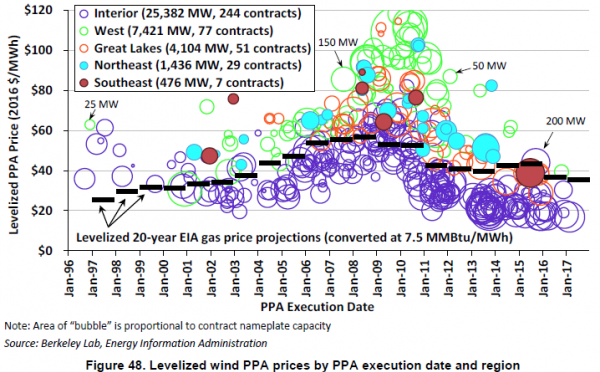Wind energy costs are lower than ever, with steady advances in technology and better wind turbine performance, according to three new reports released by the U.S. Department of Energy (DOE). New DOE reports include the “2016 Wind Technologies Market Report,” the “2016 Offshore Wind Technologies Market Report,” and the “2016 Distributed Wind Market Report.”
“The Department of Energy’s research shows that wind power is a bright spot on the American energy landscape,” said Tom Kiernan, CEO of the American Wind Energy Association (AWEA). “U.S. wind projects are already among the most productive in the world, and this new data proves we have even greater potential to deliver affordable, reliable and clean electricity to the American people.”
Wind energy has reached historically low prices according to DOE. Average prices for wind energy power purchase agreements (PPAs) fell to roughly $20/megawatt hour (MWh) last year, with some of the lowest prices in heartland states like Texas, Oklahoma and Iowa. DOE’s data showing that the average PPA price for wind has fallen by two-thirds since 2009 confirm other data showing a two-thirds decline in the levelized cost of energy (LCOE) from wind.
The two primary factors driving down the cost of wind energy are reduced wind plant costs and higher productivity. DOE data show that it costs 33 percent less, on average, to install a new wind project today compared to the peak reported in 2009 and 2010. This is a remarkable achievement, as cost reductions have been achieved while adopting longer turbine blades, using advanced materials, and making other improvements that would ordinarily tend to increase costs.
On the productivity side, technological innovations are helping wind turbines optimize their performance by reaching stronger, steadier winds. Longer blades in particular helped to boost new wind turbine performance, with wind projects built in 2014 and 2015 reporting a 42.5 percent average capacity factor in 2016, compared to a 32.1 percent capacity factor for projects built between 2004 and 2011.
DOE’s reports support AWEA data that show wind power is now the leading source of renewable energy capacity in the U.S. The wind industry deployed 8,203 megawatts (MW) in 2016, for a total of 82,143 MW of installed capacity at the end of the year— with enough wind power online today to power 25 million average American homes.
As wind power grows, so does the American workforce. The DOE found U.S. wind jobs are up 32 percent over 2015. This backs up AWEA data finding there are over 100,000 U.S. wind jobs in total.
For more analysis from AWEA, see our blog: National lab: Wind power has become historically low-cost
On the offshore side of the wind industry, global costs and prices are also falling. Europe has seen the biggest reductions in cost, though confidence is rising in the burgeoning U.S. market. The first U.S. offshore wind project came online in 2016 and over 20 projects totaling 24,135 MW of capacity are now under development according to DOE. Offshore wind turbines are trending larger, with the average global turbine size increasing from 3.4 MW in 2014 to 4.7 MW in 2016. Innovations in floating foundations could eventually unlock development opportunity in deeper waters like those off the West Coast and Hawaii.
The DOE reports distributed wind energy installations, which supply power on-site to homes, farms, businesses and communities, have grown to a total capacity of 992 MW.
This week is the inaugural #AmericanWindWeek, dedicated to U.S. leadership in wind power. Wind is the largest source of American renewable energy capacity, supporting over 100,000 U.S. jobs across all 50 states, with nearly 85,000 MW of installed capacity at the end of the second quarter of 2017.


